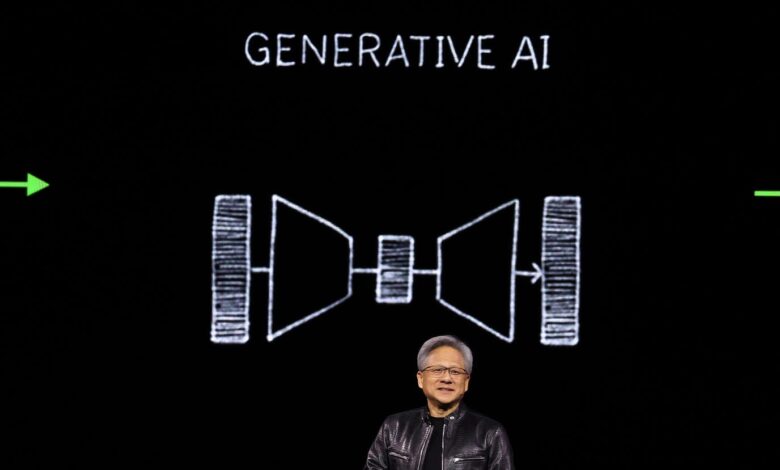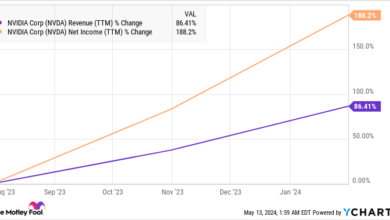Exponential Baby! Navigating The AI Convergence Of Tech With Nvidia

SAN JOSE, CALIFORNIA – MARCH 18: Nvidia CEO Jensen Huang delivers a keynote address during the … [+]
The word ‘exponential’ is one of the most abused in the English language, but in the world of technology it retains its true meaning of constantly accelerating change. This exponential growth isn’t confined to isolated pockets or a handful of industries; it’s systemic, engulfing every technology-dependent industry. Which is to say, practically all of them. But today we have a massive set of technology converging all at the same time including AI, Quantum, Spatial, Blockchain, and more. All of these technologies underpin the surging wave that is shaping the new norm of our era – a period I like to call ‘Exponential Baby.’ If we are to seize the opportunities and avoid the dangers of this growth, we need a similar rapid augmentation in our understanding of these technologies.
The Rising Tide of AI and the Exponential Impact
The world of Artificial Intelligence (AI) provides a clear illustration of this growth pattern. According to Gartner, a staggering 80% of enterprises anticipate increasing their use of generational AI by 2024. These aren’t incremental upticks; these are massive leaps in adoption. NVIDIA stands as a testament to this movement, now valued as a two-trillion dollar company largely due to their pivotal role in powering AI operations. Their success isn’t a solo journey – they’re marching alongside giants like Microsoft, Meta, Oracle, and Amazon. Their soaring chipset shipments is just one indicator of the growth trajectory we’re on.
Jensen Huang, CEO of NVIDIA, has expressed significant insights on the growth of AI and its implications. He acknowledges a “major second wave” of AI, propelled by the recognition of the need for sovereign AI that reflects the unique cultural and linguistic characteristics of each region, and the widespread adoption of AI across various industries.
TAIPEI, TAIWAN – 2023/06/01: Jensen Huang, President of NVIDIA holding the Grace hopper superchip … [+]
Huang sees NVIDIA’s advanced computing platforms as instrumental in driving this growth, noting that “NVIDIA are going to bring a ton of technology to networking” and that the exponential increase in compute throughput will span nearly 1,000 times in just a couple of years. This rapid development is not just contained within AI but extends to areas like inference computing, which now exceeds all cloud CPUs in aggregate, demonstrating NVIDIA’s significant role in fueling AI-powered consumer services.
Huang’s vision is both a lesson and warning for every business that uses technology: as we move into the twin Ages of AI and Decentralization, every technological development is interlinked and contributes to an overarching acceleration and intensification of AI capabilities and applications across the globe. This has, needless to say, fundamental implications for long-cherished organizational mindsets and business models.
For example, take AI’s contribution to productivity is a narrative that disrupts traditional labor conversations. We once fretted about AI’s potential to displace blue-collar jobs. Yet, reality portrays a more complex canvas where 46% of office legal work is automated. In a mere year, AI-driven automation spiked by 25%. And when ChatGPT arrived, it exemplified how rapidly AI could capture public attention and utility, amassing a user base that other platforms took decades to build.
Share of work that can be automated by the AI Industry by Goldman Sachs
But just as we begin to comprehend AI’s impact on every role, department and organization, the technology makes another exponential leap.
Alongside the explosive growth in AI, we’re also witnessing a remarkable convergence in the field of spatial computing. This encompasses augmented reality (AR), virtual reality (VR), and other technologies that enable digital and physical realities to coalesce. The pace of change is staggering. Companies like NVIDIA are leveraging their expertise in AI to push the boundaries of spatial computing, making it faster and more integrated into our daily lives.
This convergence is not just technical but experiential, dramatically altering how we interact with data, entertainment, and each other. Innovations in hardware, such as more powerful GPUs, and software, like sophisticated spatial algorithms, are changing the nature of digital interactions, which are fast becoming as intuitive and natural as physical ones. As spatial computing becomes more mainstream, its integration with AI will only deepen, paving the way for fully immersive experiences that are seamlessly integrated into various sectors—from gaming and entertainment to education and telepresence.
How are enterprises implementing AI? Scale AI just released their “AI Readiness” report where they surveyed 1800+ practitioners building or applying AI solutions in enterprises. Programming is the most popular use case, hence Venture Capitalist (VC) are leading very large rounds in companies like Cognition, Augment and Codeium. Codeium was recently recognized by Forbes as part of their AI 50 list, the only AI code assistant to be included.
Scale AI survey of 1800+ Ai and machine learning practitioners building or applying AI solutions in … [+]
As Varun Mohan, the CEO of Codeium, told me, “To deliver a product that is truly valuable to a developer in a professional setting, we’ve realized that more than just the state of the art LLMs, you need widespread platform availability, agnostic integrations across internal knowledge stores, and adherence to enterprise security and compliance standards, especially while case law is still being developed. Today, most tools provide targeted acceleration but we envision a world where AI will help solve the hardest problems in all parts of the software development cycle.”
Using AI in coding, particularly at Codeium, exemplifies its ability to enhance personalization and efficiency. AI coding assistants excel by integrating deep contextual insights, such as the specific third-party libraries and internal documentation relevant to a developer’s project. “Context is king,” as noted by one expert, highlighting that the more contextual data provided, the more accurate and useful the AI’s output. This personalized approach not only streamlines the coding process but also ensures that the solutions are uniquely tailored to the developer’s needs, significantly boosting productivity.
Varun Mohan, CEO of Codeium
The implication of this trend for businesses and individuals is profound. It means not only rethinking user interfaces but also reimagining how we collaborate and interact in workspaces that are no longer bound by geography. The convergence of AI and spatial computing will revolutionize industries, leading to an acceleration in remote work capabilities, training procedures, and even altering the landscape of social interactions. Leaders and organizations that understand and leverage this convergence will likely be at the forefront of the next wave of digital transformation.
Crypto’s Comeback and the Data Deluge
In addition to AI, cryptocurrency’s rebound speaks volumes about the fast-changing landscape of asset valuation. Crypto has risen from its ashes to become a leading asset class, ballooning in value at an astonishing pace, with prices now driven by hugely increased utility, rather than just speculation. The chart below from Bitwise Asset Management with data from Bloomberg Data shows that Bitcoin has led in performance 10 of the last 13 years.
Bitwise Asset Management with data from Bloomberg Data shows Bitcoin performance from 2011 through … [+]
Perhaps the most mind-boggling of all trends is the anticipated growth in data. Over the next decade, data will burgeon by approximately 660 zettabytes. To put that into perspective, it equates to around 610 more 128GB iPhones for every person on the planet.
Dealing with this data deluge is a challenge for the tech industry, but leaders in every sector must keep pace, too. How can they navigate the convergence of technology and the exponential growth in its capability, and what lessons must they learn to stay ahead of the game?
Leading Through the Change
The challenge posed by this whirling vortex of growth lies not in riding the wave but in steering through it effectively. Change management becomes pivotal. It’s about helping teams navigate through the innovation influx while fostering an environment ripe for adaptation and learning. Empathy becomes as crucial a tool as any software – understanding that while machines may not experience job insecurity, humans certainly do.
It’s encouraging to see stories of dental hygienists who proactively educate themselves in AI, recognizing that these skills are integral to their evolving roles. These actions epitomize the mindset shift required for the workforce of tomorrow. In the workplace of the future, leadership and lessons can come from the unlikeliest places, rather than the hierarchical, top-down models to which we’ve become long-accustomed. Education must flow in both directions, with teams and leaders embracing dialogue, openness, and a willingness to experiment.
ISTANBUL, TURKEY – MAY 06: A woman views historical documents and photographs displayed in a high … [+]
What’s evident is that the pace of technological change isn’t going to plateau – it’s set to accelerate. The exponential trend is here to stay, and it’s not exclusive to AI. The ripple effects are felt across blockchain, machine learning, and IoT, to name a few. With each converging technology, new possibilities and challenges emerge.
The Responsibility of Leadership in the Exponential Age
Navigating these trends necessitates a leadership style that’s dynamic, inclusive, and forward-thinking. Change management, empathy, and education form the triad of essential skills. The goal is to cultivate a culture where innovation is not just reacted to but anticipated and embraced.
Embracing ‘Exponential Baby’
‘Exponential Baby’ isn’t just a trend; it’s a paradigm shift in the technological and corporate landscape. As AI continues to evolve, and data swells to previously unimaginable levels, leaders must adapt their strategies to keep pace. This era is a test of our agility, our foresight, and our willingness to engage with technology not as a tool, but as an integral part of our evolving humanity.
We stand at the threshold of the exponential age – an era of immense potential, profound change, and boundless opportunity. As leaders, educators, and individuals, our task is to harness this potential, surf the wave of change, and emerge resilient and ready for the world of tomorrow.



